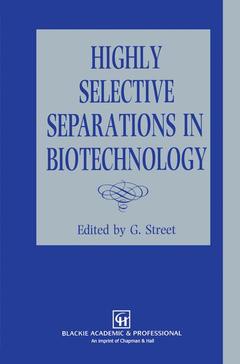Description
Highly Selective Separations in Biotechnology, Softcover reprint of the original 1st ed. 1994
Coordinator: Street G.
Language: English
Subjects for Highly Selective Separations in Biotechnology:
Keywords
biochemistry; biotechnology; chemistry; chromatography; protein; proteins; separation process
Publication date: 09-2012
231 p. · 15.5x23.5 cm · Paperback
231 p. · 15.5x23.5 cm · Paperback
Description
/li>Contents
/li>Comment
/li>
Success in meeting the challenge to produce the commercial products anticipated by the exploitation of biological processes depends upon provid ing effective separation protocols. Effectiveness can be measured in terms of selectivity, purity, resolution and validatory success. The major processing problems are associated with either the selective recovery of molecules which are present in low concentrations from complex mixtures or the selective removal of contaminants from the desired molecule. Central to the evolution of processes satisfying this demand are the regulatory requirements being imposed by governments on the purity of a product, especially in the health care market. Synthetic organic chemists are increasingly finding it advantageous to conduct one or more steps using either enzymic biotransformations where molecules with a single and consistent stereochemistry or chirality are required. The underlying princi ples behind the methods, techniques and processes currently being used and developed commercially rely upon the biospecific nature and properties of the desired molecule. When these factors are married to the more traditional techniques of precipitation, chromatography, liquid-liquid extraction and membrane processes, powerful tools emerge, allowing highly selective separations to be designed. The logical extension of these combinations is to apply genetic engineering techniques to influence the separations at a more fundamental and structural level by modifying the target protein at source, during its synthesis, to facilitate its separation in a given, selective manner, leading to the distinct possibility of producing 'designer' separation programmes.
Overview. Affinity precipitation. Membrane-based affinity separation processes. Affinity partitioning. Reverse micelles for the separation of proteins. The chemistry and engineering of affinity chromatography. Protein fusion as an aid to purification. Chiral separations. Molecular imprinting. References. Index.
Each chapter is well written, and provides a sound background understanding together with useful practical details and user experience ... It is a good source of ideas and solutions that will enable many to develop their own highly selective bioseparations. - The Genetic Engineer and Biotechnologist, This is a well put-together and presented book - highly practical in nature...Four stars. - Australian Biotechnology Association
© 2024 LAVOISIER S.A.S.




